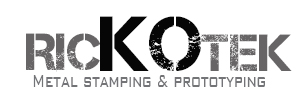We’ve learned that on quite a few projects, our clients have trouble choosing what kind of edge is best suited for their particular deep drawn stamping design.
It’s an important decision, though, as the type of edge applied can make a world of difference in terms of a ready-to-assemble and cost-efficient component.
Use this guide to find the best kind of edge so you can save money and improve part performance.
Blank And Draw With A Trimmed Flange Diameter
You should choose the ‘Blank and Draw with a Trimmed Flange Diameter’ option any time that the flanged edge of the deep drawn part is an essential assembly factor.
Additional stations or tooling in the process results in precise flange diameters. The extra tools or stations boost the cost of each part, so they’ll have a higher price tag as compared to other choices.
However, you will get pieces ready for assembly. When you design a part using this kind of edge, please be specific about things like flange and burr direction.
Blank And Draw With An Un-Trimmed Flange
Utilizing the ‘Blank and Draw with an Un-Trimmed Flange’ option for your edge type can work if your design needs to have a flanged edge, but when it’s not a crucial factor.
This particular option can save you money per each part, as there is no extra tooling, and the result is an irregular flange diameter.
It won’t be concentric in terms of the broader drawn part. When designing a part like this, please be specific about the burr side.
Shimmy Die Cut
If your chosen design needs a clean-cut edge, or your deep drawn part’s sidewalls are going to have shapes or notches, then it’s an excellent time to consider the ‘Shimmy Die Cut.’
Extra tooling is necessary to attain the precision required here, which does increase the expense of each part.
Choose this kind of edge if your design necessitates either a clean edge or any extra cut features for the open end of your draw.
Remember that in this case, the burr is going to be on the draw’s inside.
Flush Trim Cut
This particular style is an alternate option to the ‘Shimmy Die Cut’ and it’s also considerably more cost-effective.
Since this cut can happen during the actual draw process, there’s no extra tooling necessary for anywhere from 10 up to 25 percent of the stock thickness radius inside the draw.
If you deem the applicable radius as sufficient for your design, then the cup side burr won’t cause any assembly issues, meaning there’s no need for an immaculate cut.
If you would like to save money on your manufacturing costs, then this choice is certainly something you should look into.
Blank And Draw No Flange
If you want to save the most money and sidewall edges aren’t crucial to your finalized part, then go with the ‘Blank and Drawn No Flange’ option.
No extra tooling or design costs are involved since the edge can be shaped irregularly. The finished edge is going to be varied and inconsistent, just based on the thickness of the stock material and the draw depth.
The burr happens on the interior of the draw. If your final assembled product doesn’t need a precision edge on your deep drawn parts, then you can cut some of the production costs during the design stage.
Pinch Trim Cut
When you have a design that doesn’t have to have a flange, and you can live with some slight flaring at the edge of the deep drawn part you’re creating, then consider the ‘Pinch Trim Cut’ option.
The thickness of the material is what will determine the flaring size on the draw’s open end. If you use the ‘Pinch Trim Cut’ edge, then you can design your deep drawn part while being very specific about your break, burr side, and cut preferences.
You should note that particular combinations of burr direction, depth, and material thickness might require extra tooling. On the other hand, the overall goal is doing all of this all in one process, so that costs are lower.
Industries That Frequently Use Deep-Drawn Stamping
Many different industries utilize deep-drawn stamping for its versatility in forming metal sheets into a variety of hollow and axisymmetric shapes.
Stampers that use this particular manufacturing technique work with dies so they can shape big metal sheets, known as blanks, into very specific forms.
This kind of stamping method is unique from many other metal stamping techniques because it creates much deeper components and objects than other methods can ever hope to accommodate.
In actuality, stamping is usually only known as deep drawing if the item depth is equivalent to or longer than the radius.
This particular process is used most frequently for the production of cylindrical components, although other shapes are possible too, ranging from boxes to more sophisticated geometries.
With this broad range of capabilities, deep-drawn stamping is usable for the creation of many different subcomponents useful in settings ranging from industrial to residential, including but not limited to the following:
-Automotive parts
-Baking pans
-Beverage cans
-Casings
-Plumbing fixtures
-Sinks
-Many more products
One of the primary advantages of deep-drawn stamping is how it allows for high volume production but at relatively low costs.
This sort of efficiency can happen even when highly accurate tolerances are necessary given how the process can keep happening with minimal downtime after the proper molds are cast and appropriate dies are configured.
Deep-drawn stamping has made itself crucial to many different members of the international manufacturing community, so let’s explore a handful of the more common industrial uses now:
Aerospace
This industry is very reliant on deep-drawn stamping for the manufacturing of very accurate subcomponents used in airplanes.
These subcomponents have to be able to put up with the harsh environmental conditions and severe fluctuations in pressure that airplanes go through regularly.
Deep-drawn stamping works well with aluminum and many other lightweight materials that prove essential to aerospace manufacturing.
Aerospace manufacturers utilize this technique to build things ranging from enclosures and equipment casing to seat and motor components.
Consumer Goods
Given the variety of shapes that deep drawn stamping can accommodate, there are also a significant number of different consumer goods fabricated with this technique.
Deep drawing allows for the efficient and cost-effective creation of many standard home tools and receptacles, including pots, pans, and cans. Other notable options include but are not limited to the following:
-Furniture subcomponents
-Home and garden decor
-Trash cans
-Storage and/or food/beverage containers
Agriculture
Deep-drawn stamping is usable in making many different irrigation and plumbing system components, given how a lot of these parts need axisymmetric shapes, which can resist leaking but also put up with many different weather situations and corrosion risks.
The following includes just some of the many agricultural subcomponents that are manufactured via the process of deep-drawn stamping:
-Casings
-Connectors
-Irrigation pipes
-Pumps
Medicine/Pharmaceutical
Pharmaceutical and medical tools require very accurate manufacturing to comply with stringent industry standards. They are frequently made out of steel alloys, or other metals have given how easily disinfected these materials are.
Since deep drawn stamping works with many different tolerances, geometries, and biocompatibility issues that medical device makers require, this particular technique is commonly employed in producing subcomponents for:
-Oxygen tanks
-Surgical devices
-Syringes
-Thermometer probe covers
-A variety of other medical technologies
Military
Deep drawn stamping can produce a massive amount of intricate items with fast turnaround times and with tight tolerances.
That makes it very useful for specific military applications that depend on this particular technique to create weapon components and casings.
On top of the advantages that deep drawn stamping provides the manufacturing of weapon components, it also allows for part creation for military craft and vehicles ranging from aquatic machines to airplanes. Some specific instances of those abilities include:
-Body and engine mounts
-Exhaust mufflers
-Jounce bumpers
Energy
Deep drawn stamping is useful for creating some of the energy industry’s most crucial electrical components, including solenoids and batteries.
The process can also prove helpful in making many of the components prevalent to electric substations, as well as generator enclosures.

